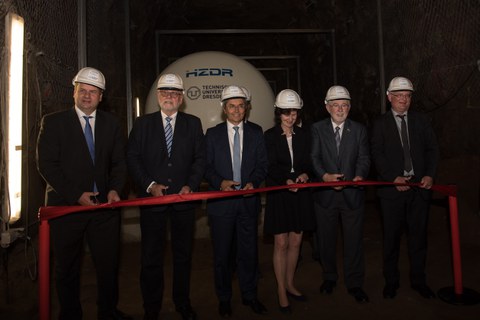Jun 28, 2017
Topping-out ceremony for the Accelerator Laboratory in the Felsenkeller

Festive topping-out ceremony for the accelerator laboratory in the Felsenkeller. Dirk Hilbert, Prof. Peter Joehnk, Prof. Hans Müller-Steinhagen, Dr. Eva-Maria Stange, Nobel laureate Prof. Arthur McDonald and Dr. Michael Stötzel symbolically cut the red ribbon at the entrance to the Felsenkeller laboratory.
Today, in the Dresden Felsenkeller the topping-out ceremony for the joint accelerator laboratory of TU Dresden and Helmholtz-Zentrum Dresden-Rossendorf (HZDR) was celebrated. In the underground experimental facility, physicists plan to reconstruct the processes inside stars. About 150 guests, including the Saxon State Minister for Higher Education, Research and the Arts Dr Eva-Maria Stange, the responsible Head of Division at the Federal Ministry of Education and Research Dr Michael Stötzel, and Dresden's mayor Dirk Hilbert acknowledged the progress of the construction work and the research project. Keynote speaker at today's ceremony was the Nobel laureate Professor Arthur McDonald, who – in 2015 – received the Nobel Prize in Physics for his discovery of neutrino oscillations, together with Takaaki Kajita.
On the south-western outskirts of Dresden, a experimental facility is being built, which is unique in Germany. TU Dresden and HZDR are constructing an underground accelerator in two tunnels of the former ice storage facility of the Felsenkeller brewery. Upon completion, the facility will enable the investigation of nuclear fusion reactions and will elucidate in detail how the sun and other stars fuse atomic nuclei at their core, producing heavy elements. The rocks above the tunnel insulate the experiments from external influences such as cosmic radiation, so that particularly sensitive material research can be conducted in the accelerator laboratory.
At the end of April, the Pelletron accelerator, which is to be jointly exploited by HZDR and TU Dresden, was installed in the deepest particle laboratory in Germany. In 2012, the research centre bought the plant from a British private company that had used it for pharmaceutical development. Since then, the Saxon researchers have refitted the accelerator for its new tasks ahead. For the physicists Dr Daniel Bemmerer of HZDR and Prof. Kai Zuber of TU Dresden the underground accelerator in the former ice storage of the Felsenkeller brewery is a dream come true. Soon, they will start hunting particles in the underground corridors of Felsenkeller, and will be able to reconstruct the processes inside stars, unaffected by radiation.
Prof. Arthur McDonald, the Canadian Nobel Laureate in Physics, sees optimal research conditions in the Felsenkeller laboratory: "This new accelerator in its low-radioactivity underground location will enable measurements of nuclear processes in stars that generate elements from which we and our planet are made."
In her opening address, the Saxon State Minister for Higher Education, Research and the Arts, Dr Eva-Maria Stange, pointed out: "With the particle accelerator in the Felsenkeller laboratory, the possibilities for experimentation for scientists from Germany and abroad take on a new quality. The experimental facility, which is unique in Germany, makes the tunnels a mecca for astrophysics from all over the world. It is a very nice thought to look into the depths of the stars from within the depths of a cellar underneath the city of Dresden. What happens billions of light years away is suddenly very close indeed – an exciting idea and in the truest sense of the word: a magical moment for Saxon research. I would like to thank the HZDR and TU Dresden that their intensive cooperation has made this possible."
The excellent co-operation is also emphasised by the HZDR Administrative Director Prof Peter Joehnk and TU Dresden’s Rector Prof Müller-Steinhagen.
“The HZDR and the University of Excellence, two strong partners within the DRESDEN-concept research alliance, have come together for this project. It clearly shows how we intend to jointly advance science here in Dresden – through infrastructures that provide our researchers with innovative tools for exploration”, states Prof. Peter Joehnk.
Prof. Müller-Steinhagen considers the Felsenkeller laboratory a prime example for the lived networking between the Dresden scientific institutions. "Helmholtz-Zentrum Dresden-Rossendorf and TU Dresden are closely interlinked by an intensive co-operation in research and teaching. This invaluable co-operation now culminates in the construction of a jointly operated accelerator laboratory in the former ice storage facility of the Felsenkeller brewery."
Dr Michael Stötzel, Head of Devision 714 at the Federal Ministry of Education and Research, on the occasion of the topping-out ceremony praises the expertise of Dresden-based scientists and the operation of accelerators and detectors: "This know-how is beneficial to the accelerator laboratory in the Felsenkeller. It is also envisaged to allocate beam time to measuring equipment, so that they can look into the interior of stars, shielded from cosmic radiation. I am sure that the new laboratory, with its unique potential, will quickly establish itself in the international scientific community; and I would like to wish all stakeholders excellent results in the field of research on matter and material research."
Media Inquiries
Kim-Astrid Magister, TUD
Tel.: +49 (0) 351 463-32398
